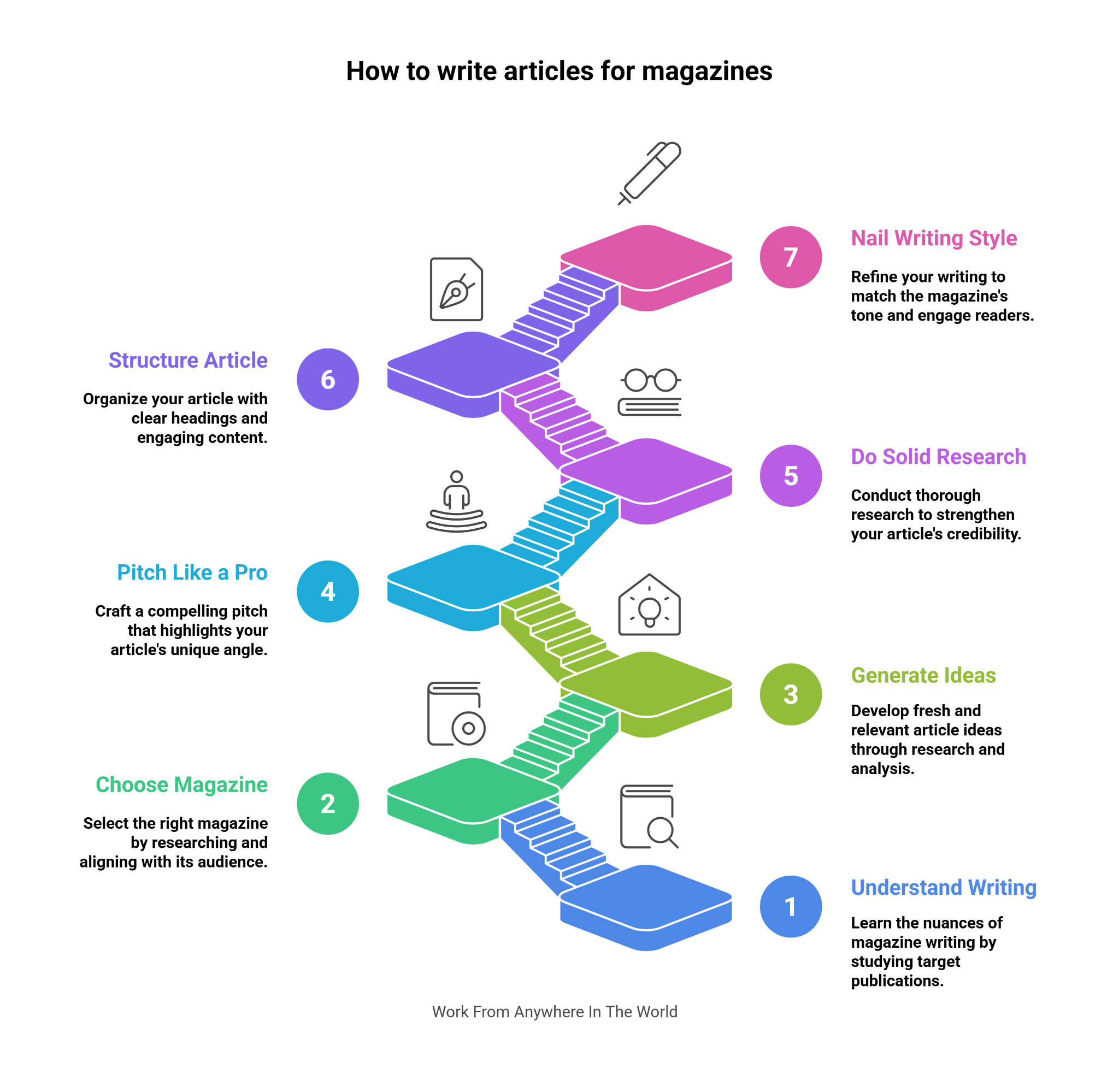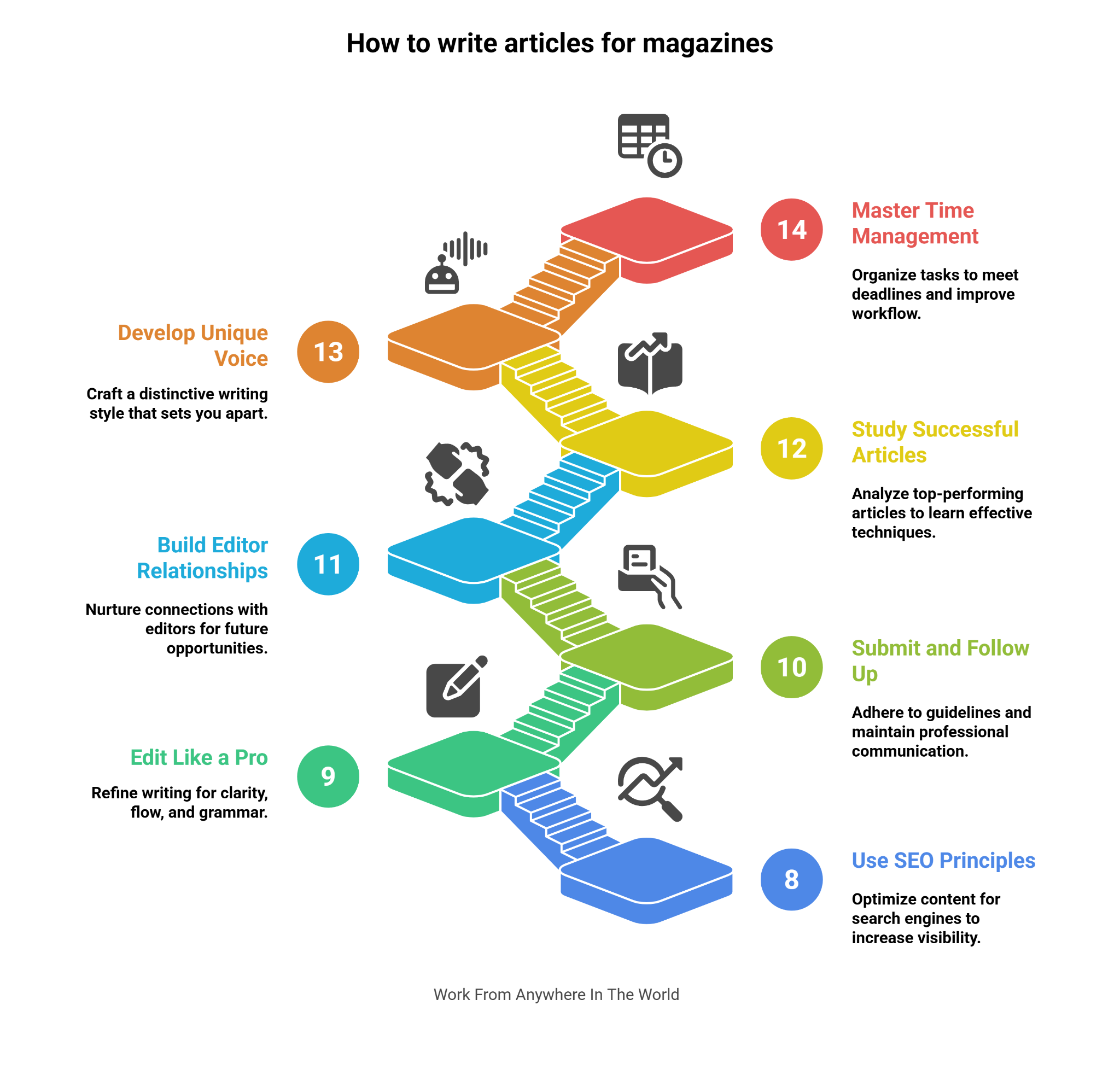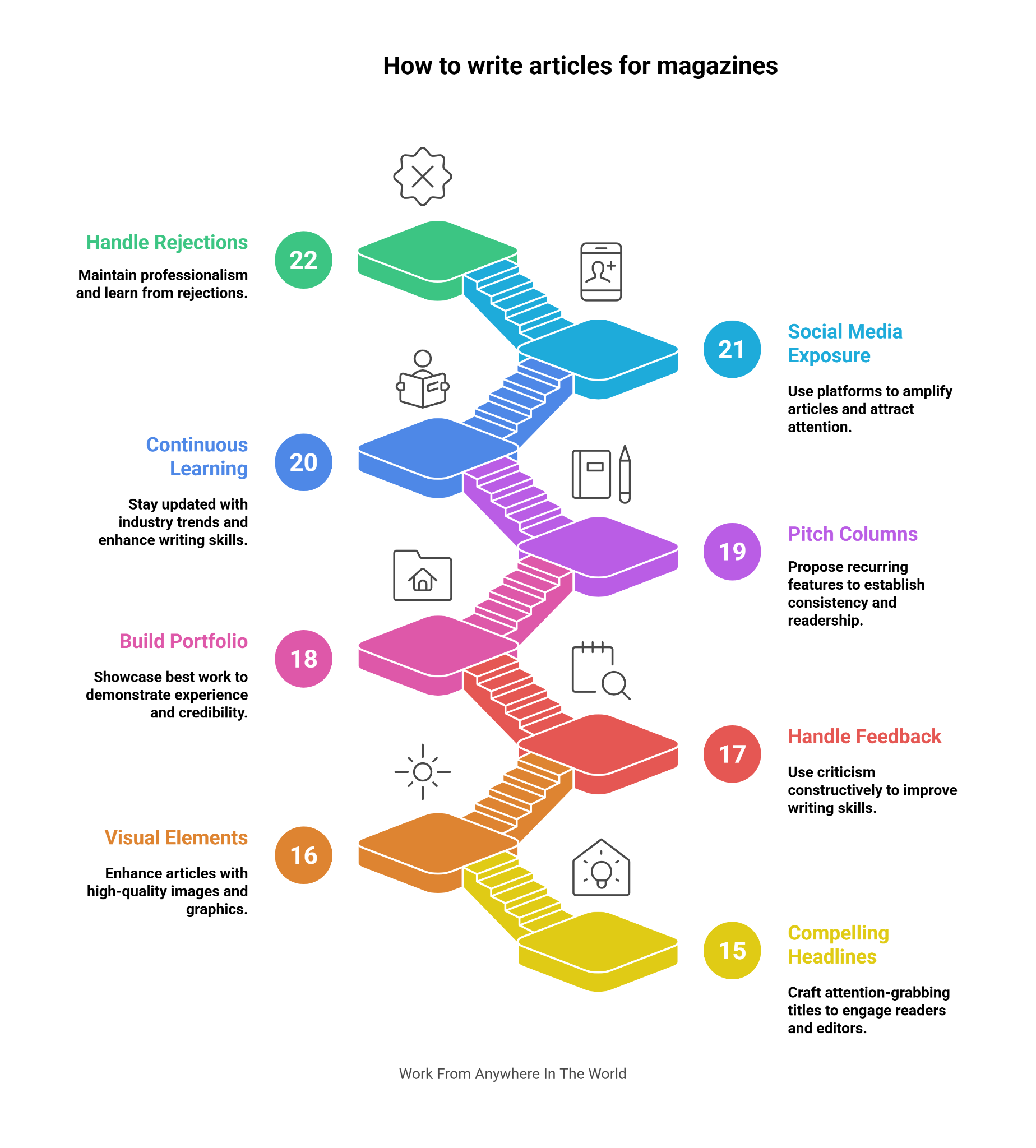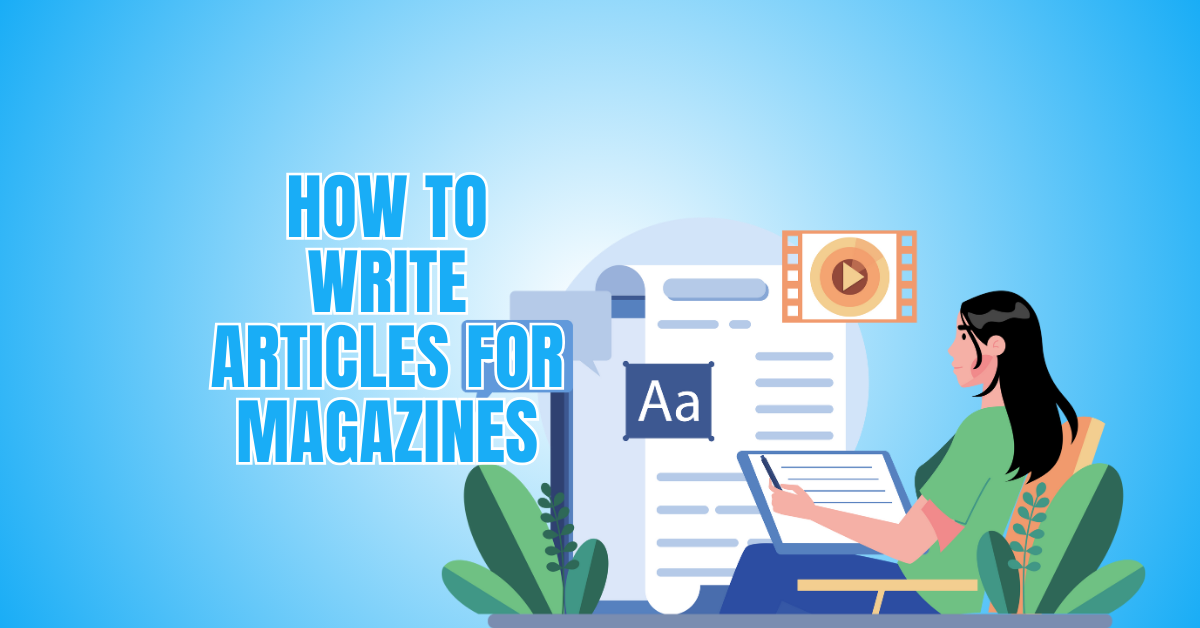How To Write Articles For Magazines
Many aspiring authors dream of writing for magazines, but it takes strategy, imagination, and perseverance to make that goal a reality.
Mastering how to write articles for magazines is essential for turning your ideas into polished, publishable stories that captivate both editors and readers.
Whether you want to share expertise, tell stories, or build credibility, learning how to write for magazines opens exciting doors.
This manual takes you step-by-step through the process of writing articles that editors and readers will find engaging.
Why Write For Magazines?
Let’s start with a simple question. Why do people want to write for magazines?
1. Exposure
Writing for magazines exposes your work to thousands, sometimes millions, of readers. This wide visibility can attract opportunities, build your reputation, and connect you with a diverse audience who may follow your future work across different platforms and publications.
2. Credibility
Being published in a respected magazine instantly boosts your credibility. It signals to readers, editors, and clients that your writing is professional, polished, and trustworthy. This recognition helps you stand out and positions you as an expert in your niche.
3. Income
Magazine writing can be financially rewarding. Many publications pay competitive rates for articles, features, and essays. This allows writers to earn income while pursuing their passion, turning creativity into a sustainable career, and gaining long-term financial benefits from consistent assignments.
4. Creativity
Magazines encourage creativity by letting writers explore diverse formats and topics. Whether it’s storytelling, interviews, or features, you can bring unique ideas to life. This freedom allows you to showcase your personal style while captivating readers with fresh and engaging narratives.
5. Networking
Writing for magazines helps you build strong connections. You’ll interact with editors, fellow writers, and experts through assignments and interviews.
These networks open doors to collaborations, future writing opportunities, and a stronger professional presence in the publishing industry.
6. Skill Development
Magazine writing sharpens essential skills like research, interviewing, and storytelling. With each article, you improve clarity, precision, and impact.
These enhanced abilities prepare you for bigger projects, diverse opportunities, and long-term growth in your writing and publishing career.
Steps To Write Articles For Magazines
Step 1: Understand Magazine Writing
Writing for magazines is different from other formats. It’s not a novel, where you have hundreds of pages to develop a story. It’s not a casual blog, where personal opinions dominate. It’s structured and polished.
To do it well, start by reading several issues of your target magazine. Notice how articles flow, how introductions hook readers, and how subheadings guide the story. Practice writing short, clear paragraphs.
Focus on balancing creativity with professionalism. Editors expect fresh angles, accuracy, and engagement. Every word matters, so choose carefully, revise often, and aim to entertain and inform.
Step 2: Choose The Right Magazine
Not every magazine is a fit for your article. To do this effectively, start by researching publications in your niche. Visit their websites, read several recent issues, and note the topics, tone, and style.
Look for magazines whose audience matches your expertise or story idea. Ask yourself: would my article resonate with their readers? Consider length, format, and submission guidelines.
Take notes on their voice and style, then adapt your writing accordingly. Choosing the right magazine increases your chances of acceptance and ensures your article connects with an engaged and interested audience.
Step 3: Generate Strong Article Ideas
Fresh ideas capture the editors’ attention. Begin by coming up with ideas for subjects that are pertinent to your intended publication.
Look for trends, seasonal hooks, or unresolved problems readers face. Personal experiences, interviews, or unique perspectives work well.
Use online research, social media, and competitor analysis to spot gaps. Write a list of potential angles, then narrow them to the most unique and engaging. Ask yourself: why would readers care?
A strong idea has clarity, originality, and relevance. When pitching, clearly explain the story’s angle, what makes it new, and why it fits the magazine’s audience.
Step 4: Pitch Like A Pro
A pitch is your first impression. Keep it short, polite, and focused. Begin with a hook, summarize your idea in two or three sentences, and highlight its unique angle.
Include a brief bio mentioning your experience or previous publications. Send it directly to the editor via email, following submission guidelines carefully. Avoid generic or vague proposals.
Personalize each pitch to the magazine and explain why your story matters now. Track responses, and follow up politely if needed. A strong pitch can open doors even before your article is written.
Step 5: Do Solid Research
Research strengthens your article and builds credibility. Begin by identifying trustworthy sources, including books, academic papers, and reputable websites. Conduct interviews with experts or people with firsthand experience.
Gather statistics, case studies, and examples to support your points. Keep organized notes and verify facts to avoid errors. The research should inform, but not overwhelm, your story.
Use quotes and real-life anecdotes to make your article engaging. Research also helps you discover fresh angles editors may appreciate. Accurate, thorough research makes your writing professional and trustworthy, increasing your chances of acceptance.
Step 6: Structure Your Article
A clear structure guides readers and keeps them engaged. Start with an attention-grabbing headline that accurately sums up your story.
Open with an introduction that hooks attention, then break the body into subheadings covering one key idea each. Use short paragraphs, lists, and examples to make content scannable. Include quotes, facts, or case studies for authority.
End with a firm conclusion that provides takeaways or calls to action. Planning your structure before writing makes drafting faster and smoother. Editors notice organized articles, and readers stay engaged when the flow is logical and clear.
Step 7: Nail Your Writing Style
Magazine writing should feel natural, yet professional. Use conversational language and active voice to engage readers. Paint vivid pictures with descriptive words, but avoid unnecessary fluff.
Short sentences improve readability, especially for busy readers. Include anecdotes, examples, or rhetorical questions to maintain interest. Keep paragraphs concise and focused.
Adapt your tone to the magazine—formal, humorous, or casual, depending on its style. Read your draft aloud to check flow and clarity. Writing in a lively, polished style increases both reader enjoyment and your likelihood of acceptance by editors.

Step 8: Use SEO Principles
Even magazine articles benefit from SEO. Editors want articles that perform online. Incorporate keywords naturally in titles, subheadings, and body text. Break content into short, scannable paragraphs.
Use bullet points and numbered lists where helpful. Include relevant statistics, quotes, or links to authoritative sources. Optimize images and captions if submitting digitally. Avoid keyword stuffing—focus on readability.
SEO-friendly content increases your article’s reach, making it easier for readers to discover your work. Your article will appeal to both search engines and human readers if you strike a balance between SEO and engaging writing.
Step 9: Edit Like A Pro
Editing transforms good writing into excellent writing. Review your draft for clarity, flow, and grammar. Cut unnecessary words and tighten sentences.
Ensure each paragraph focuses on one idea. Check facts, quotes, and data. Read aloud to catch awkward phrasing or repetition.
Adjust tone and style for consistency. Consider peer feedback if available. A polished article shows professionalism and respect for the editor’s time.
Multiple editing rounds are regular; never submit your first draft. Remember, minor improvements in editing can dramatically increase the impact and readability of your article.
Step 10: Submit And Follow Up
Follow submission guidelines carefully. Send your article in the required format—Word, Google Docs, or PDF. Include your contact info and any requested author bio.
After submitting, wait patiently; response times vary. If you haven’t heard back in a couple of weeks, send a polite follow-up email.
Avoid being pushy. Maintaining professionalism in communication helps you build a positive reputation. Keep track of submissions, deadlines, and feedback.
Timely, courteous follow-ups show dedication and respect, increasing your chances of acceptance for current and future articles.
Wealthy Affiliate – Mini Review (2025)
If you’ve ever thought about turning your blog, passion, or niche into an online business,
Wealthy Affiliate (WA) is one of the most beginner-friendly platforms I’ve used.
It combines step-by-step training, website hosting, SEO research tools,
and an active community all in one place.
What I like most: you can start free (no credit card needed),
explore lessons, test the tools, and connect with other entrepreneurs
before upgrading. WA isn’t a “get rich quick” scheme — it’s a platform where success comes
from consistent effort and applying what you learn.
Step 11: Build Relationships With Editors
Successful magazine writers nurture relationships with editors. Meet deadlines consistently and respond promptly to emails. Accept feedback gracefully, showing willingness to revise and improve.
Pitch fresh, relevant ideas regularly to demonstrate initiative. Networking with editors and fellow writers can lead to collaborations, referrals, and recurring assignments.
Maintain professionalism and a positive attitude, even after rejections. Long-term relationships create trust, making editors more likely to consider you for high-profile stories.
Building rapport is as essential as writing skills—it can open doors to more opportunities and a sustainable magazine-writing career.
Step 12: Study Successful Articles
To write like a pro, start by reading top-performing magazine articles. Analyze structure, tone, pacing, and how they hook readers. Notice how facts, anecdotes, and quotes are integrated.
Identify patterns that make the writing engaging, but don’t copy. Highlight strong openings, clever transitions, and memorable conclusions.
Consider how subheadings and visuals guide readers. Take notes on what resonates and why. Then, practice applying these techniques to your own articles.
Studying successful work teaches you the standards expected by editors, improves your writing instincts, and gives concrete examples of storytelling techniques that captivate readers.
Step 13: Develop Your Unique Voice
Your voice sets you apart from other writers. Experiment with tone, sentence length, word choice, and rhythm until your writing feels authentic. Adapt it to suit the magazine’s style, but maintain a consistent personality.
A recognizable voice makes your articles memorable and enjoyable—practice by rewriting the same article in different styles. To improve it, get input from mentors or peers.
Over time, your voice becomes a signature that editors and readers recognize. Combining originality with magazine-appropriate style increases your chances of publication and helps you create work that stands out in a crowded market.
Step 14: Master Deadlines And Time Management
Editors rely on writers who meet deadlines. Develop a schedule that balances research, drafting, editing, and submitting. Break large tasks into smaller, manageable chunks.
Use tools like calendars, timers, or project management apps to track your progress. Start projects early to allow time for revisions and unexpected delays.
Prioritize assignments by urgency and complexity. Learning to manage time reduces stress and increases output quality.
Being punctual not only improves your reputation with editors but also creates consistency in your workflow, making you a dependable writer capable of handling multiple assignments successfully.

Step 15: Use Compelling Headlines
Headlines are the first impression of your article. They must be clear, concise, and intriguing to attract both editors and readers.
Spend time brainstorming multiple variations before deciding on one. Use action words, numbers, or questions to increase curiosity.
Make sure it reflects the content accurately; misleading headlines harm credibility—test headlines on friends or colleagues for impact.
A strong headline helps your article stand out in submissions and boosts online engagement. Editors appreciate writers who can craft titles that capture attention while conveying the story’s essence effectively.
Step 16: Incorporate Visual Elements
Many magazines publish content both in print and online, where visuals enhance reader engagement. Use high-quality photos, charts, or infographics to complement your text.
Visuals should clarify, illustrate, or add interest without overwhelming the article. Learn basic graphic tools or source images legally through stock websites. Include captions that provide context and tie visuals to your story.
Collaborate with photographers or designers when possible. Strong visual elements make articles more professional, accessible, and memorable.
They can also improve online SEO performance, as images help search engines understand your content while appealing to visual readers.
Step 17: Handle Feedback Positively
Receiving edits or rejections is part of the magazine-writing process. Consider criticism as a chance to do better and approach it with an open mind.
Carefully review editorial suggestions, ask clarifying questions when needed, and make revisions promptly. Avoid taking criticism personally; focus on how it strengthens your article.
Learning from feedback builds professionalism and demonstrates respect for editors. Over time, applying constructive criticism hones your skills, sharpens your style, and improves your chances of future acceptance.
Writers who respond positively to feedback develop lasting relationships with editors and gain a reputation as cooperative, adaptable, and growth-oriented.
Step 18: Build a Portfolio
A portfolio showcases your best work, demonstrating experience, versatility, and credibility to editors or clients. Include published articles, links, PDFs, and a brief description of each piece.
Organize it by topic, publication, or style for easy navigation. A strong portfolio allows editors to see your capabilities at a glance, making it easier to pitch new stories.
Update it regularly with fresh work, even unpublished drafts, to reflect growth and range. A well-maintained portfolio is also helpful for freelance opportunities, speaking engagements, or networking. It’s a tangible record of your writing accomplishments and professionalism.
Step 19: Pitch Recurring Columns
Once you gain credibility, consider pitching a regular column or recurring feature. Editors appreciate writers who can deliver consistent, high-quality content on a specific topic.
A recurring column builds a loyal readership, increases your exposure, and creates steady assignments. Prepare a clear proposal outlining your column concept, frequency, and potential story ideas.
Highlight your expertise and previous work. Be flexible to adapt your concept to the magazine’s needs. Successfully maintaining a recurring column establishes you as a reliable contributor, strengthens your professional relationship with editors, and enhances your profile in the publishing community.
Step 20: Keep Learning And Adapting
The publishing industry constantly evolves, and writers must evolve too. Stay updated on trends, topics, and reader preferences.
Attend webinars, workshops, or conferences to enhance skills. Experiment with new genres, formats, or writing techniques.
Follow successful writers and publications to learn emerging practices. Regularly assess your work, noting areas for improvement. Adaptability allows you to stay relevant, attract diverse assignments, and appeal to multiple editors.
Writers who continuously learn grow both creatively and professionally. This commitment ensures long-term success and positions you as a forward-thinking, competitive contributor in the magazine industry.
Step 21: Leverage Social Media For Exposure
Social media can amplify your articles and attract editors’ attention. Share your published work on platforms like LinkedIn, Twitter, and Instagram with engaging captions and hashtags. Tag the magazine or editor when appropriate.
Responding to queries or comments from readers demonstrates professionalism and cultivates a following. Observing trending topics online can also inspire article ideas.
Social media presence indicates that your work reaches an audience beyond the magazine itself, increasing your credibility. Consistent sharing strengthens your personal brand and may lead to more writing opportunities.
Step 22: Learn To Handle Rejections Gracefully
Rejections are inevitable in magazine writing. Don’t take them personally—they are part of the process. Analyze feedback if provided, and learn from it. Consider revising the article for another magazine or pitching a new idea.
Maintain professionalism by thanking editors for their time and keeping communication positive. Building resilience helps you stay motivated and persistent, which is key to long-term success.
Writers who handle rejection gracefully are often remembered favourably by editors, increasing the chances of future acceptance and cultivating a reputation as a mature, reliable professional.

Conclusion
Writing for magazines is both an art and a skill. It requires research, creativity, structure, and professionalism. By understanding magazine style, generating strong ideas, and building relationships with editors, you can create articles that engage readers and stand out.
Persistence, adaptability, and continuous learning are key. Learning how to write articles for magazines is crucial for developing engaging, professional content that appeals to both editors and readers. Start small, practice consistently, and watch your writing career flourish in the magazine world.
I trust you enjoyed this article on How To Write Articles For Magazines. Please stay tuned for more insightful blogs on affiliate marketing, online business, and working from anywhere in the world.
Take care!
— JeannetteZ
💬 Your Opinion Is Important To Me
Do you have thoughts, ideas, or questions? I’d love to hear from you. Please leave your comments below or email me directly at Jeannette@WorkFromAnywhereInTheWorld.com.
📚 More Work From Anywhere Reads
🚀 Ready to Build a Business You Can Run from Home
Or from Anywhere in the World?
Imagine creating income on your terms — from home, a cozy café, or wherever life takes you.
With the right tools, training, and community support, it’s entirely possible.
Start your own online business for free — no credit card needed.
Disclosure
This post may contain affiliate links. As an Amazon Associate and participant in other affiliate programs, I earn from qualifying purchases at no extra cost to you. Please read my full affiliate disclosure.







